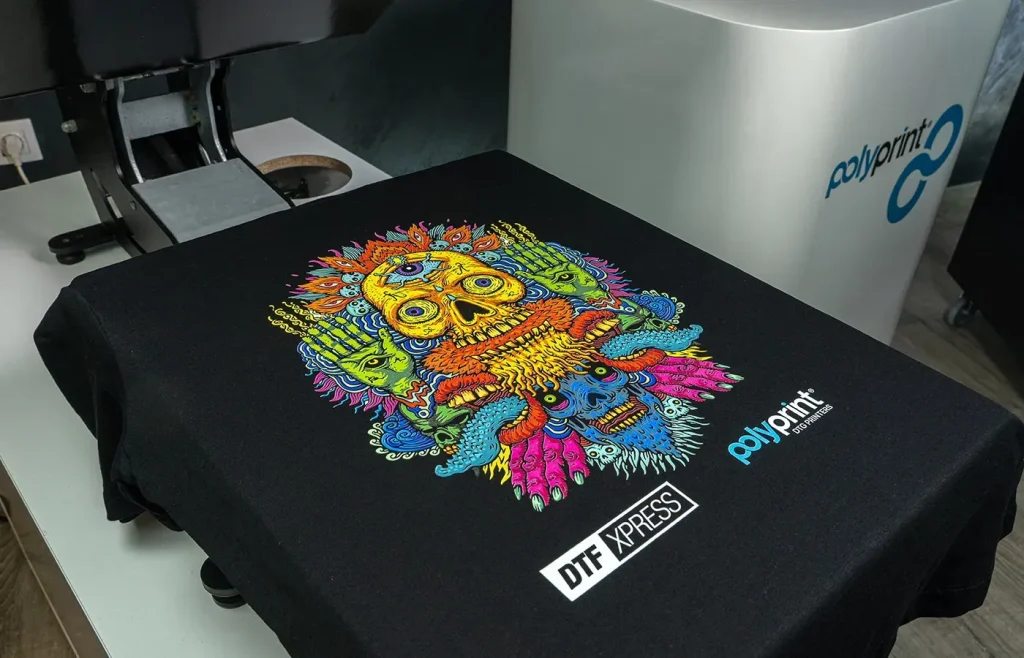DTF Printing, or Direct-to-Film printing, is revolutionizing the textile printing landscape by enabling vibrant, long-lasting designs with exceptional efficiency. This innovative technique involves transferring printed designs from a special film directly onto various fabrics, offering artists and businesses a powerful tool for custom creations. In our exploration of DTF Printing, you’ll discover essential tips and tricks designed to enhance your print quality improvement and expand your creative possibilities. As we delve into the world of DTF, we’ll cover everything from heat press techniques to material selection, ensuring that your projects achieve the stunning aesthetics and durability desired. So, whether you’re a seasoned professional or just starting your printing journey, understanding DTF Printing will elevate your textile projects to new heights.
Direct-to-Film, commonly referred to as DTF printing, represents a standout method in the realm of textile and fabric decoration. This advanced form of printing stands out due to its ability to produce intricate, high-resolution designs that can be seamlessly applied to a wide range of materials. As we dissect the intricacies of DTF printing, we will uncover various strategies aimed at optimizing print outcomes, such as selecting the right transfer films and mastering heat application procedures. By focusing on innovative practices tailored for direct-to-film methods, designers and print professionals alike can achieve remarkable results that captivate and inspire. Embrace this transformative printing technology to enhance your craft and deliver stunning visual experiences.
Understanding the Basics of DTF Printing
DTF Printing, or Direct-to-Film printing, has emerged as a revolutionary technique in the realm of textile printing. This method allows designs to be printed onto a special film that is then transferred to fabric using heat and pressure. Unlike traditional screen printing, DTF Printing boasts numerous advantages such as exceptional color vibrancy and the ability to print on a broad spectrum of materials, including cotton and polyester blends. Its beginner-friendly approach, coupled with cost-effectiveness for small runs, makes it an enticing option for both startups and established businesses.
One of the most compelling features of DTF Printing lies in its versatility. This technique can help printers adapt to varying fabric surfaces, ensuring that designs remain sharp and vibrant regardless of the material. With DTF, users gain access to quick print runs and dependable quality, which is particularly appealing for those looking to fulfill bulk orders or innovative custom projects. As the textile printing industry evolves, understanding the fundamentals of DTF is key to unlocking its potential.
Essential Tips for High-Quality DTF Printing
Achieving high-quality prints with DTF requires careful attention to various factors that contribute to successful outcomes. Material selection plays a crucial role; choosing premium DTF films that are specifically engineered for this printing technique can significantly enhance both the texture and color vibrancy of your designs. Additionally, ensuring that your printing inks are of the highest quality will further yield greater adherence and color richness. It’s essential to experiment with different film and ink combinations to discover what works best for your specific applications.
Another critical aspect of high-quality DTF Printing is the optimization of printer settings. Setting your printer resolution to at least 1440 DPI is fundamental for capturing intricate designs and ensuring razor-sharp images. Furthermore, employing proper color management through accurate ICC profiles tailored to your inks and materials will enhance color consistency and minimize discrepancies in output. By mastering printer settings alongside material choices, you set the stage for outstanding print quality that stands out in today’s competitive market.
Mastering Heat Press Techniques for DTF Printing
The heat press is a pivotal tool in DTF Printing, playing a vital role in transferring designs onto fabrics successfully. To achieve optimal results, invest in a high-quality heat press that features adjustable pressure and temperature settings to accommodate various textile materials. Typically, a temperature around 300°F (149°C) for 15-20 seconds works well for most applications, but experimenting with settings is encouraged to find the perfect balance for different fabric types.
Moreover, the technique used during the application is crucial for ensuring strong adhesion. The timing and method of peeling the transfer film can significantly affect the durability and quality of the print. Utilizing a hot peel method allows the ink to adhere more strongly to the fabric, enhancing its longevity. By perfecting heat press techniques, you can ensure that your DTF Prints not only look stunning but also stand the test of time through washes and daily wear.
Post-Processing Practices for Durable DTF Prints
Post-processing is an often overlooked but essential step in DTF Printing that impacts the durability of your designs. Curing, for instance, is vital for enhancing the washability and durability of the print. This step can be as simple as exposing the freshly transferred design to additional heat or allowing it to cure over time, ensuring that the ink adheres properly and resists fading.
Additionally, providing proper washing instructions is critical for maintaining the vibrancy of designs printed with DTF techniques. Encouraging customers to follow guidelines such as cold washing and air drying can significantly prolong the life and quality of printed garments. By implementing thorough post-processing practices, you can greatly enhance customer satisfaction and reduce the rate of returns due to premature fading or cracking.
Recent Developments in DTF Printing Technology
The landscape of DTF Printing is constantly evolving, with new technological advancements that promise to push the boundaries of what is achievable in textile printing. Recent developments have seen the introduction of advanced printers and high-performance inks, which collectively enhance the efficiency and vibrancy of print outputs. These innovations not only lead to higher quality prints but also contribute to productivity improvements that benefit both small businesses and large printing operations.
Moreover, as the barrier to entry in DTF technology lowers due to reductions in equipment costs, more individuals and small businesses are embracing this innovative approach to textile printing. This democratization of technology signifies a shift in the industry, where creativity and innovation can thrive regardless of the size or scale of operation. As DTF Printing techniques advance, so do opportunities for printers to leverage these changes for custom, high-quality textile solutions.
Embracing the Versatility of DTF Printing in Your Projects
One of the most exciting aspects of DTF Printing is its versatility, allowing creatives to explore limitless possibilities in their textile projects. Whether you’re looking to produce custom apparel, promotional items, or unique home decor, DTF printing caters to a broad range of applications. This flexibility not only empowers artists and designers to broaden their creative horizons but also meets the demands of diverse market trends and consumer preferences.
Moreover, DTF Printing allows for straightforward production modifications, enabling quick adjustments to designs and materials without significant downtime or investment. By leveraging the ease of DTF Printing, businesses can quickly respond to market changes and customer requests, providing tailored solutions that drive engagement and satisfaction. Thus, the versatility of DTF acts as a powerful catalyst for innovation and creativity within the textile printing industry.
Frequently Asked Questions
What is DTF printing and how does it work?
DTF printing, or Direct-to-Film printing, is a method that involves printing designs onto a special film that is then transferred to fabric using heat and pressure. This process allows for vibrant colors and durable prints on various textile types.
What are some essential DTF printing tips for beginners?
For beginners in DTF printing, key tips include selecting high-quality films and inks, ensuring a printer resolution of at least 1440 DPI, and mastering heat press techniques. Understanding the correct timing for peeling the film is crucial for achieving optimal adhesion.
How can print quality be improved in DTF printing?
Improving print quality in DTF printing can be achieved by using the right print settings, such as high DPI resolutions and accurate color management with ICC profiles. Additionally, investing in quality materials and mastering the curing process enhances the longevity of vibrant prints.
What types of fabrics can be used for DTF printing?
DTF printing is versatile and can be applied to a variety of fabrics, including cotton, polyester, and fabric blends. This flexibility allows for a wide range of textile printing applications, making it ideal for custom apparel and promotional items.
What are the best heat press techniques for DTF printing?
The best heat press techniques for DTF printing include using a heat press set to around 300°F (149°C) for 15-20 seconds. It’s also important to experiment with pressure settings and to use a hot peel method for enhanced ink adherence and durability.
How should I care for garments printed with DTF techniques?
Garments printed using DTF techniques should be washed with care. It’s recommended to perform cold washes and air dry to prevent fading and cracking, thus maintaining the vibrant and quality of the prints.
| Key Aspect | Details |
|---|---|
| Understanding DTF Printing | A method transferring a design from special film onto fabric, using heat and pressure. |
| Advantages | 1. Vibrant colors 2. Versatility (works on various fabrics) 3. Cost-effective for small runs 4. Quality consistency for bulk orders |
| Key Tips | 1. Material Selection: Use high-quality DTF films and inks, and reliable hot-melt adhesive. 2. Printer Settings: Set high resolution (at least 1440 DPI) and use accurate ICC color profiles. 3. Application Techniques: Quality heat press with correct settings and timing for peeling. 4. Post-Processing: Cure designs for durability and provide proper washing instructions. |
| Recent Developments | New technology is improving efficiency and affordability in DTF printing, making it accessible to small businesses and hobbyists. |
Summary
DTF printing is a revolutionary approach that is reshaping the textile printing landscape, providing enthusiasts and professionals with vibrant, durable designs efficiently. By focusing on essential aspects such as material selection, printer settings, application techniques, and post-processing methods, anyone can achieve stunning results in their printing projects. With ongoing advancements that further enhance the quality and accessibility of DTF printing, the technology promises endless possibilities for creativity and innovation in fabric printing.



